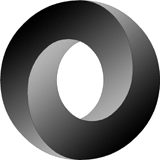
 |
Introducing JSON |
json
element
value
object
array
string
number
"true"
"false"
"null"
object
'{' ws '}'
'{' members '}'
members
member
member ',' members
member
ws string ws ':' element
array
'[' ws ']'
'[' elements ']'
elements
element
element ',' elements
element
ws value ws
string
'"' characters '"'
characters
""
character characters
character
'0020' . '10ffff' - '"' - '\'
'\' escape
escape
'"'
'\'
'/'
'b'
'n'
'r'
't'
'u' hex hex hex hex
hex
digit
'A' . 'F'
'a' . 'f'
number
int frac exp
int
digit
onenine digits
'-' digit
'-' onenine digits
digits
digit
digit digits
digit
'0'
onenine
onenine
'1' . '9'
frac
""
'.' digits
exp
""
'E' sign digits
'e' sign digits
sign
""
'+'
'-'
ws
""
'0009' ws
'000A' ws
'000D' ws
'0020' ws
JSON (JavaScript Object Notation) is a lightweight data-interchange format. It is easy for humans to read and write. It is easy for machines to parse and generate. It is based on a subset of the JavaScript Programming Language, Standard ECMA-262 3rd Edition - December 1999. JSON is a text format that is completely language independent but uses conventions that are familiar to programmers of the C-family of languages, including C, C++, C#, Java, JavaScript, Perl, Python, and many others. These properties make JSON an ideal data-interchange language.
JSON is built on two structures:
These are universal data structures. Virtually all modern programming languages support them in one form or another. It makes sense that a data format that is interchangeable with programming languages also be based on these structures.
In JSON, they take on these forms:
An object is an unordered set of name/value pairs. An object begins with { (left brace) and ends with } (right brace). Each name is followed by : (colon) and the name/value pairs are separated by , (comma).

An array is an ordered collection of values. An array begins with [ (left bracket) and ends with ] (right bracket). Values are separated by , (comma).

A value can be a string in double quotes, or a number, or true or false or null, or an object or an array. These structures can be nested.

A string is a sequence of zero or more Unicode characters, wrapped in double quotes, using backslash escapes. A character is represented as a single character string. A string is very much like a C or Java string.

A number is very much like a C or Java number, except that the octal and hexadecimal formats are not used.

Whitespace can be inserted between any pair of tokens. Excepting a few encoding details, that completely describes the language.